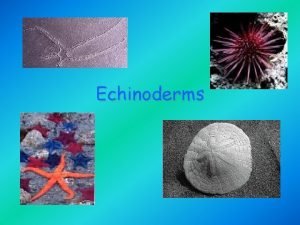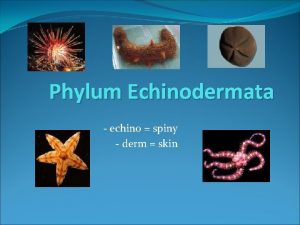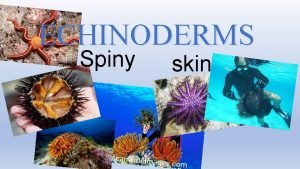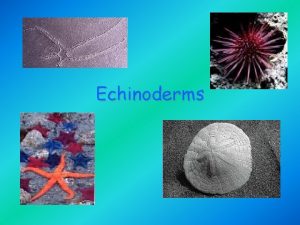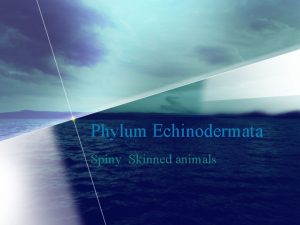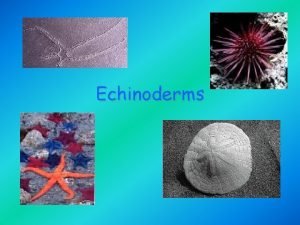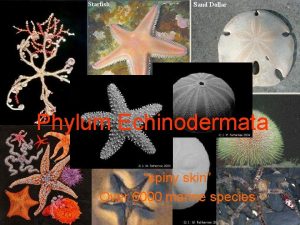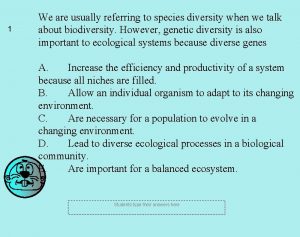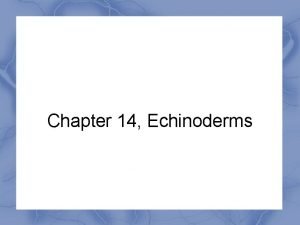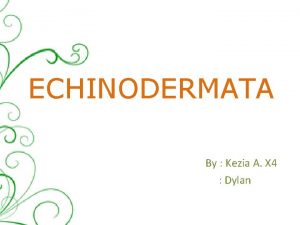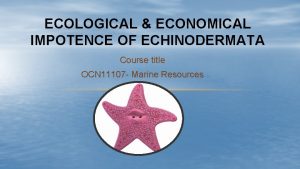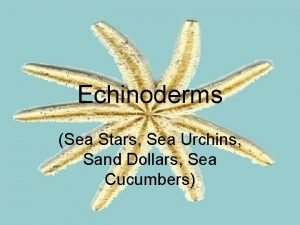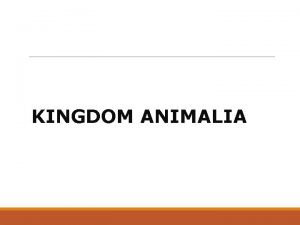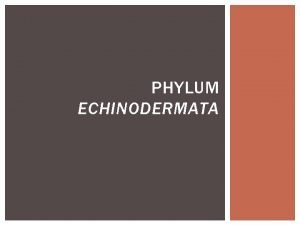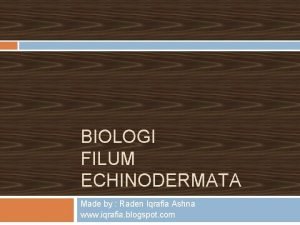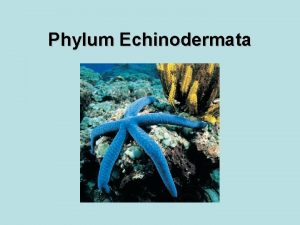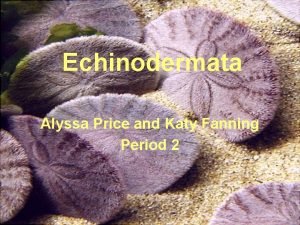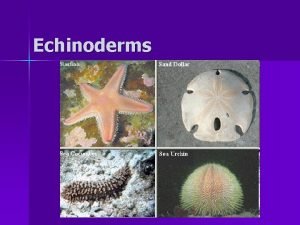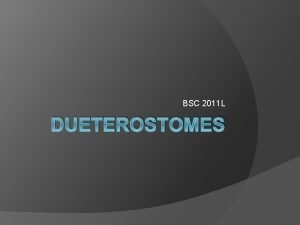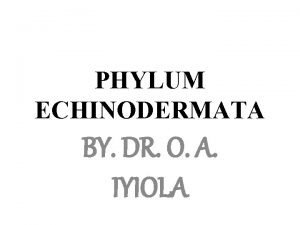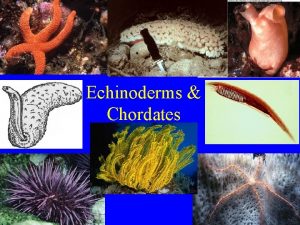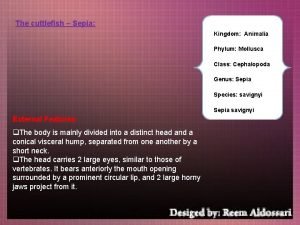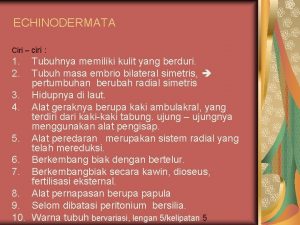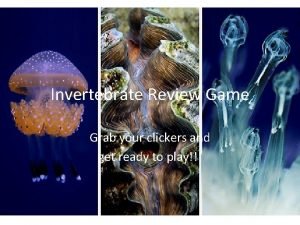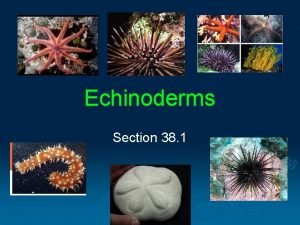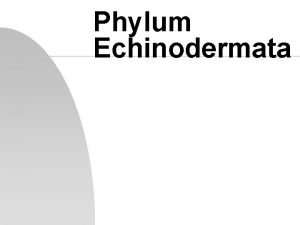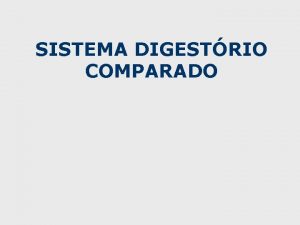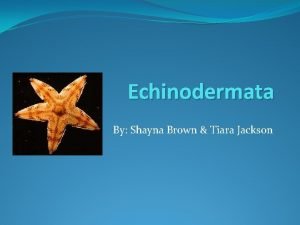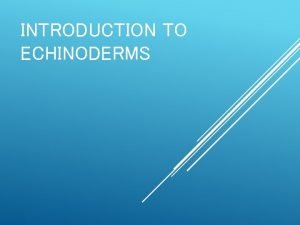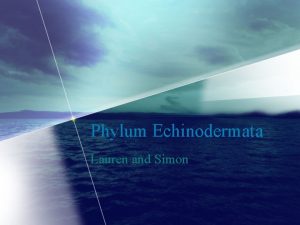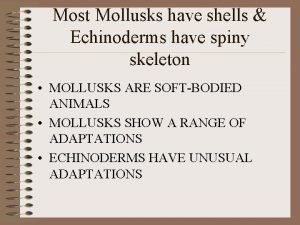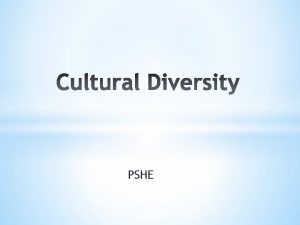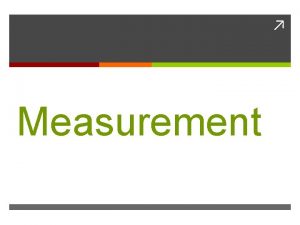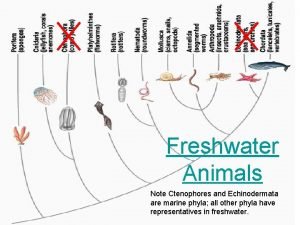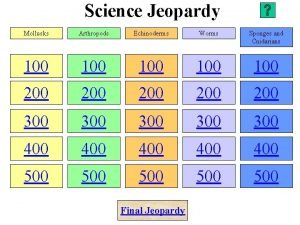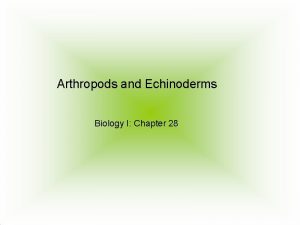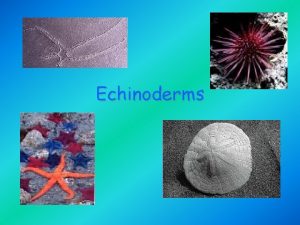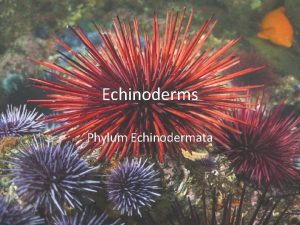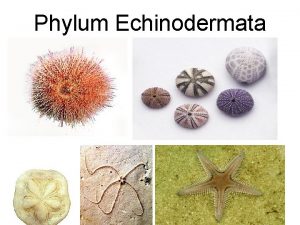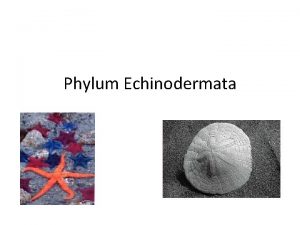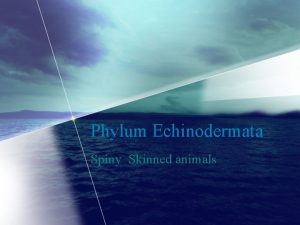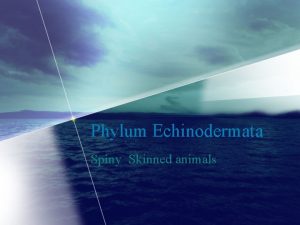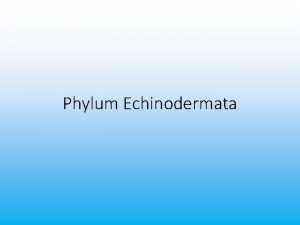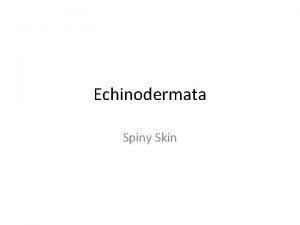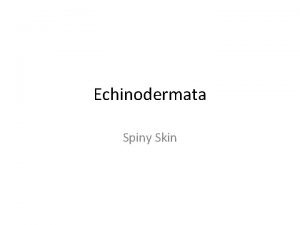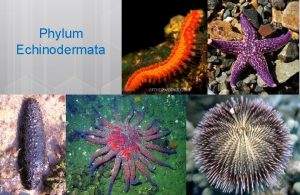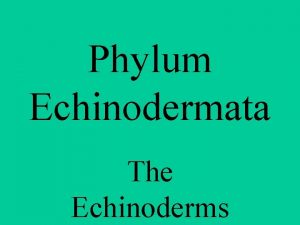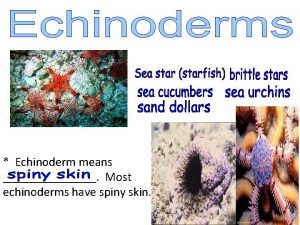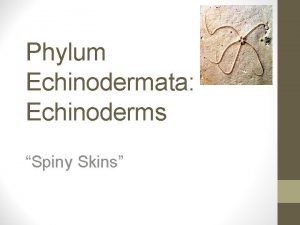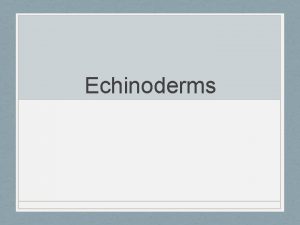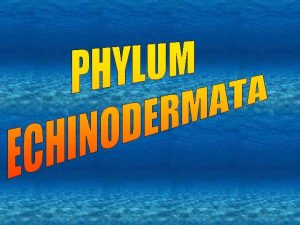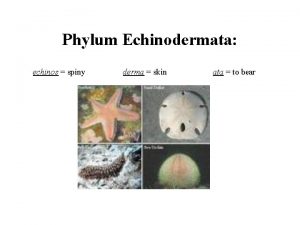Echinoderms Diversity Echinodermata means spiny skin Echinoderms usually














































- Slides: 46

Echinoderms

Diversity Ø Echinodermata means “spiny skin” Ø Echinoderms usually inhabit shallow coastal waters and ocean trenches Ø organisms in this phylum: • • Sea stars Brittle stars Sand dollars Sea cucumbers


Characteristics Ø change from a free-swimming bilaterally symmetrical larva to a bottom-dwelling adult with radial symmetry. Ø Most have five radii or multiples which is known as pentaradial symmetry Ø they have an endoskeleton that is made up of calcium plates, may include protruding spines

Ø Have small feet called tube feet that aid in movement, feeding, respiration, & excretion. Ø Do not have circulatory, respiratory or excretory systems. Ø Have a nervous system but no head or brain. Ø There are two sexes and they can produce sexually and asexually.

Evolution & Classification Ø Echinoderms are from the Cambrian period & date back to over 500 million years ago Ø Scientists believe that they evolved from bilaterally symmetrical ancestor. Ø Records show that conditions have changed which had caused them to evolve from sessile organisms to freeliving ones.

Taxonomists have divided 6, 000 species of echinoderms into five classes:

Ø Crinoidea sea lilies, feather stars Ø Asteroidea stars Ø Ophiuroidea basket stars, brittle stars Ø Echinoidea sand dollars, sea urchins Ø Holothuroidea sea cucumbers


Crinoidea Ø They include: (“lilylike”) Ø Sea lilies Ø Feather stars Ø Crinoidea are sessile Ø they have long stalks that attach to rocks or to the ocean floor Ø feather stars eventually detach themselves Ø Sticky tube feet that are at the end of each arm catch food and serve as a respiratory surface.

Asteroidea (“star-like”) Ø starfish or sea stars belong in this class Ø found all over coastal shores around the world Ø prey on oysters, clams, and other sea food that is used by people




Ophiuroidea (“snakelike”) Ø largest echinoderm class Ø includes basket stars & brittle stars Ø primarily reside under stones & in crevices and holes of coral reefs Ø have thin brittle arms that break off & regenerate themselves quickly Ø feed by raking food off the ocean floor with their arms and bottom of tube feet Ø also trap food with mucous strands between their spines. Ø Shell called a test encloses body


Echinoidea (“hedgehoglike”) Ø sand dollars & sea urchins Ø test: rigid endoskeleton that the internal organs are compacted in Ø Aristotle’s lantern: complex jaw-like mechanism that is used to grind their food Ø locomotion: tube feet Ø protection: barbs on their long spines that are sometimes venomous


Sand dollars Ø live along seacoasts & sandy areas Ø flat, round shape bodies; and adaptation for shallow burrowing Ø locomotion: short spines (also aid in burrowing & cleaning their bodies) Ø use tubes to filter food out of water


Holothuroidea Ø sea cucumbers belong in this class Ø bodies are soft Ø how they feed: tentacles around the mouth sweep up sediment from the water Ø protection: eject internal organs through the anus : Lost parts are later regenerated. Process called evisceration



Sea Cucumber eating • https: //www. youtube. com/watch? v=i. YSb. Lrm. Vk. M • https: //www. youtube. com/watch? v=VOPnr 8 BVQHc copyright cmassengale


Structure & Function of Seastar

Body Plan of the Sea Star Ø oral surface: mouth located on the underside of the body Ø aboral surface: top of the body Ø ossicles: sharp protective spines made of calcium plates, covered with thin epidermal layer Ø pedicellariae: tiny forceps that protect and clean the body surface

Water-Vascular System Ø hydrostatic pressure permits movement Ø Path of water in the Water-Vascular System u enters sieve plate u passes through stone canal u traces a path from the ring canal encircling mouth to 5 radial canals that extend to each arm

Copyright © The Mc. Graw-Hill Companies, Inc. Permission required for reproduction or display. Water-Vascular System of a Sea Star

Copyright © The Mc. Graw-Hill Companies, Inc. Permission required for reproduction or display. Body Wall and Internal Anatomy of a Sea Star

Tube foot Ampulla Lateral canal Body wall Tube foot Sucker

Anatomy Tube feet and ambulacral groove Oral surface Aboral surface Oral spines -around the mouth

Aboral surface

Oral surface



Ø ampulla: bulblike sac that each foot connects to Ø feet contract, water enters and are able to suction onto surface of slippery rocks

Feeding & Digestion Ø uses feet Ø eat mollusks, worms, and slow-moving animals Ø enzymes help digest food

Other Body Parts Ø fluid in coelom bathes organs & distributes nutrients & oxygen Ø skin gills: protect coelom lining; gases are exchanged Ø nerve ring: surrounds mouth & branches off into nerve cords in each arm. Ø Eyespots: on each arm that responds to light Ø tentacles: responds to touch

Reproduction Ø each arm produces sperm & egg Ø occurs externally Ø bipinnaria: free-swimming larva that a fertilized egg develops into Ø settles in the bottom and develops into an adult through metamorphosis Ø reproduce asexually by regenerating lost parts






 Five arms covered with spiny skin on top
Five arms covered with spiny skin on top Spiny skeleton
Spiny skeleton Endoskeleton and usually a spiny skin
Endoskeleton and usually a spiny skin Echinodermata
Echinodermata Spiny skinned invertebrates
Spiny skinned invertebrates Spiny skin
Spiny skin Spiny skinned phylum
Spiny skinned phylum Levels of biodiversity
Levels of biodiversity Humectants milady
Humectants milady Thick skin
Thick skin Thin skin vs thick skin
Thin skin vs thick skin The high rate of poaching of rhinoceros is due mostly to
The high rate of poaching of rhinoceros is due mostly to Genetic diversity and biodiversity
Genetic diversity and biodiversity Ecosystem jigsaw activity
Ecosystem jigsaw activity Characteristics of echinoderms
Characteristics of echinoderms Sistem saraf echinodermata
Sistem saraf echinodermata Echinodermata
Echinodermata Sand dollars anatomy
Sand dollars anatomy Filum animalia
Filum animalia Mollusca endoskeleton
Mollusca endoskeleton Bentuk tubuh crinoidea
Bentuk tubuh crinoidea Phylum
Phylum Echinodermata germ layers
Echinodermata germ layers Phylum echinodermata facts
Phylum echinodermata facts Echinodermata
Echinodermata Crinoidea
Crinoidea Echinodermata triploblastic
Echinodermata triploblastic Echinodermata cuttlefish
Echinodermata cuttlefish Ciri ciri echinodermata
Ciri ciri echinodermata Asexual reproduction of budding
Asexual reproduction of budding Class asteroidea examples
Class asteroidea examples Brittle stars phylum
Brittle stars phylum Estrela do mar
Estrela do mar Body cavities
Body cavities Spiny skinned animals have an endoskeleton formed with
Spiny skinned animals have an endoskeleton formed with Spiny plates phylum
Spiny plates phylum Japanese spiny lobster origami
Japanese spiny lobster origami Spiny skeleton
Spiny skeleton Cultural diversity means a range of different
Cultural diversity means a range of different Triangle quadrilateral pentagon hexagon octagon
Triangle quadrilateral pentagon hexagon octagon Meta'' means morphe'' means
Meta'' means morphe'' means Meta and morph means
Meta and morph means Bio means 'life
Bio means 'life Dermal ossicles
Dermal ossicles Order of animal
Order of animal 5 advanced characteristics shared by cephalopods
5 advanced characteristics shared by cephalopods Chapter 28 arthropods and echinoderms
Chapter 28 arthropods and echinoderms
